

51 Pegasi b. Name[edit] The name 51 Pegasi b is the official astronomical name of the planet.
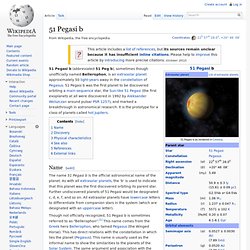
As with all extrasolar planets, the 'b' is used to indicate that this planet was the first discovered orbiting its parent star. Further undiscovered planets of 51 Pegasi would be designated c, d, e, f, and so on. All extrasolar planets have lowercase letters to differentiate from companion stars in the system (which are designated with an uppercase letter).
HD 24040 b. HD 24040 b is a long-period exoplanet taking approximately 3700 days to orbit at 4.92 astronomical units in a circular orbit.
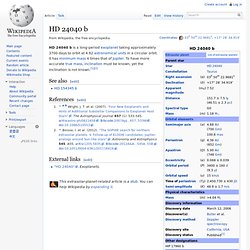
It has minimum mass 4 times that of Jupiter. To have more accurate true mass, inclination must be known, yet the inclination is not known.[1][2] HD 128311 c. 42 Draconis b. COROT-6b. COROT-6b (previously named COROT-Exo-6b)[3] is an exoplanet that was reportedly discovered by the COROT mission team on February 2, 2009 orbiting the unidentified star COROT-6.
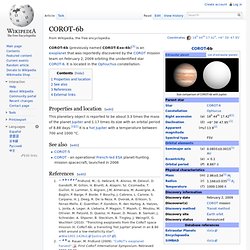
It is located in the Ophiuchus constellation. Properties and location[edit] This planetary object is reported to be about 3.3 times the mass of the planet Jupiter and 1.17 times its size with an orbital period of 8.88 days.[1][2] It is a hot Jupiter with a temperature between 700 and 1000 °C. See also[edit] References[edit] ^ Jump up to: a b c d e f Fridlund, M.; G. External links[edit] HAT-P-13b. HAT-P-13b is an extrasolar planet approximately 700 light-years away in the constellation Ursa Major.
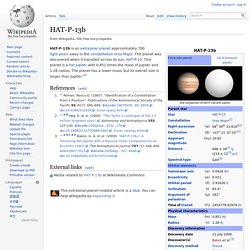
The planet was discovered when it transited across its sun, HAT-P-13. This planet is a hot Jupiter with 0.851 times the mass of Jupiter and 1.28 radius. HD 204313 b. HD 204313 b is an extrasolar planet which orbits the G-type main sequence star HD 204313, located approximately 155 light years away in the constellation Capricorn.

This planet orbits the star at a distance of 3.082 astronomical units and takes 1931 days or 5.29 years to revolve around the star. It has minimum mass four times that of Jupiter. However the radius and inclination are not known since this planet was not detected by transit method or direct imaging. Kepler-41b. Pulsar planet. Pulsar planets are planets that are found orbiting pulsars, or rapidly rotating neutron stars.
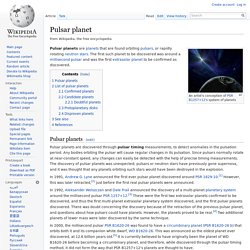
The first such planet to be discovered was around a millisecond pulsar and was the first extrasolar planet to be confirmed as discovered. Pulsar planets[edit] Pulsar planets are discovered through pulsar timing measurements, to detect anomalies in the pulsation period. Any bodies orbiting the pulsar will cause regular changes in its pulsation. HD 45364 c. HD 45364 c is an extrasolar planet located approximately 107 light years away[1] in the constellation of Canis Major, orbiting the eighth magnitude G-type main sequence star HD 45364.
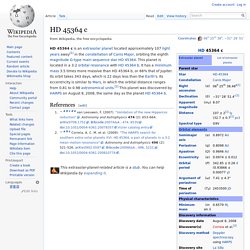
This planet is located in a 3:2 orbital resonance with HD 45364 b. It has a minimum mass 3.5 times more massive than HD 45364 b, or 66% that of Jupiter. Its orbit takes 343 days, which is 22 days less than the Earth’s. Its eccentricity is similar to Mars, in which the orbital distance ranges from 0.81 to 0.98 astronomical units.[2] This planet was discovered by HARPS on August 8, 2008, the same day as the planet HD 45364 b. Coordinates: 06h 25m 38s, −31° 28′ 51″ Kepler-36b.
Chthonian planet. Artist's conception of HD 209458 b transiting its star.

HD 209458 b is an example of a planet that is in the process of having its atmosphere stripped away, though it is not itself a chthonian planet nor is it expected to become one in the near future. [clarification needed] COROT-7b may be the first chthonian planet discovered.[2][3] Chthonia (from Greek: Χθών) means "of the Earth".
The term was coined by Hébrard et al., since the term chthonian generally refers to Greek deities from the infernal underground. See also[edit] HD 73534 b. Coordinates:

23 Librae b. 23 Librae b (23 Lib b) is an extrasolar Jovian planet discovered in 1999 orbiting the star 23 Librae.
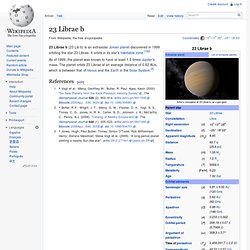
It orbits in its star's habitable zone.[1][2] PSR B1257+12 C. Name[edit] Artist’s impression of PSR B1257+12 d. The planets of PSR B1257+12 are designated from A to D (ordered by increasing distance). GJ 3021 b. GJ 3021 b is an extrasolar planet[3] approximately 57 light-years away in the constellation of Hydrus. The planet is a Jupiter-like planet orbiting about 0.5 AU from its star with a minimum mass 3.37 times that of Jupiter, as determined by measuring variations in the radial velocity of the star. A study published in 2001 suggested that the usual inability to determine the orbital inclination of an extrasolar planet through radial velocity measurement had caused this mass to be severely underestimated.[4] The astrometric orbit gives an orbital inclination of 11.8° and a mass of 16 Jupiter masses, which would make the object a brown dwarf.
However later analysis showed that Hipparcos was not sensitive enough to accurately determine astrometric orbits for substellar companions, which means the inclination (and hence the true mass) of the planet are still unknown.[5] Kepler-36b. HD 87883 b. HD 87883 b is an extrasolar planet which orbits the K-type main sequence star HD 87883, located approximately 59 light years away in the constellation Leo Minor. It is a long-period planet, taking seven and a half years to orbit the star at the average distance of 3.60 AU.
However this planet orbits in a very eccentric path, which ranges distance from as close as 1.69 AU to as far as 5.51 AU. This planet was detected by radial velocity method on August 13, 2009.[2] HD 88133 b. HD 88133 b is an extrasolar planet orbiting the star HD 88133. It is probably less massive than Jupiter and even Saturn. It orbits the star in a very tight orbit, completing one revolution around the star in every three and half days or so. Despite the relatively large radius of the star (about 2 times Solar), no transits have been detected.[1][2] References[edit] External links[edit] "HD 88133". Coordinates: 42 Draconis b. Gliese 777 b. The signal produced by the planet is very weak and the eccentricity was originally supposed to be very circular which led to speculations of a very Jupiter-like planet, with a system of several large moons like Jupiter itself.
Fortunately, the inner system should be stable for Earth-like planets despite a known, smaller inner Neptune-like planet which is known to orbit the star at distance of 0.12 AU every 17 Earth days. References[edit] External links[edit] Coordinates: HD 11964 b. Kepler-11d. Gliese 176 b. The initial announcement confused the planetary periodicity with the stellar periodicity of 40 days, thus giving a 10.24 day period for a 25 Earth-mass planet.[2] Subsequent readings filtered out the star's rotation, giving a more accurate reading of the planet's orbit and minimum mass. HD 290327 b.